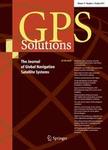版权所有:内蒙古大学图书馆 技术提供:维普资讯• 智图
内蒙古自治区呼和浩特市赛罕区大学西街235号 邮编: 010021

作者机构:Univ New S Wales Sydney NSW 2052 Australia
出 版 物:《GPS SOLUTIONS》 (地球定位系统应用)
年 卷 期:2008年第12卷第3期
页 面:199-209页
核心收录:
学科分类:070801[理学-固体地球物理学] 07[理学] 08[工学] 0708[理学-地球物理学] 0816[工学-测绘科学与技术]
主 题:GPS receiver CW interference RAIM algorithm carrier to noise ratio (C /No)
摘 要:In the global positioning system (GPS), code division multiple access (CDMA) signals are used. Because of the known spectral characteristics of the CDMA signal, continuous wave (CW) interference has a predictable effect on the different pseudo random noise (PRN) spreading codes (unique to each satellite) depending on the Doppler frequency of the signal. The Doppler frequency for each signal is also predictable once the receiver position is known. As different satellite signals have different Doppler frequencies, the effect on the signal quality is also different. In this paper first the effect is studied analytically. The concept of an exclusion zone is defined and analyzed for each satellite. This exclusion zone, where that satellite should not be used due to interference degradation, is shown to be predictable for each satellite as a function of time. Using this prediction, the CW interference effect on the positioning quality of the receiver can be mitigated by ignoring the affected satellites within exclusion zones when performing position evaluation. The threshold beyond which a satellite should be excluded is then derived by studying the mutual effects of the geometry and the signal quality of that satellite on the positioning quality. Receiver autonomous integrity monitoring (RAIM) uses redundancy in measurements to perform an internal consistency check to see if all of the measurements are satisfactory. In this paper this technique is also used to mitigate the effect of CW interference on the positioning accuracy. Finally it is shown that the prediction of the exclusion zone for each satellite outperforms the RAIM algorithm in mitigation the effect of the interference when 5 satellites are visible.